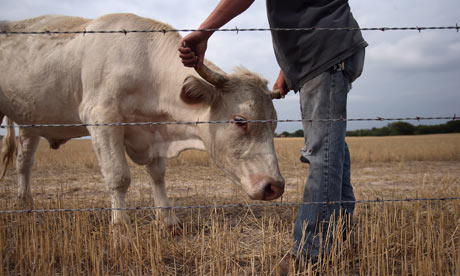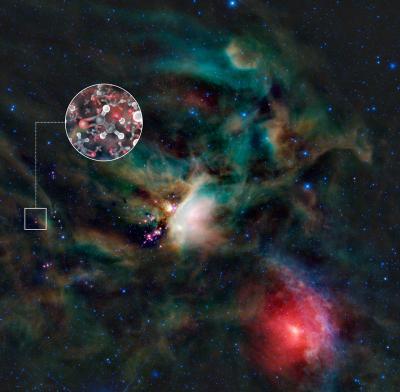Bigfoot Hoaxer Killed in Accident
A Montana man was struck and killed by cars Sunday night while trying to hoax a Bigfoot sighting. The Montana Highway Patrol reported that Randy Lee Tenley of Kalispell was pronounced dead at the scene on U.S. Highway 93 south of Kalispell after being hit by two cars consecutively.
Tenley's death will likely reignite a long-standing debate within the Bigfoot community: Would it be ethical to shoot and kill a Bigfoot? Some say yes, because that's the only way to prove they exist, and once proof is found, funds could be made available to protect them as an endangered species. Others say no, that because Bigfoot sightings are so rare, they must have very small populations and killing one might drive the animals to extinction. Ecological ethics aside, aiming a gun at a Bigfoot could be a bad idea. You simply can't know for sure if the mysterious, burly figure you have lined up in your sights is the real beast, or a bear, or a hoaxer in a costume. |  |
Rooted in experience: The sensory world of plants
HAVE you ever wondered what the grass under your feet feels, what an apple tree smells, or a marigold sees? Plants stimulate our senses constantly, but most of us never consider them as sensory beings too. In fact senses are extremely important to plants. Whatever life throws at them, they remain rooted to the spot - they cannot migrate in search of food, escape a swarm of locusts or find shelter from a storm. To grow and survive in unpredictable conditions, plants need to sense their environment and react accordingly. Some people may not be comfortable describing what plants do as seeing, hearing, smelling, tasting and touching. They certainly lack noses, eyes, ears, mouths and skin, but in what follows, I hope to convince you that the sensory world of plants is not so very different from our own.
|  |
Food shortages could force world into vegetarianism, warn scientists
Leading water scientists have issued one of the sternest warnings yet about global food supplies, saying that the world's population may have to switch almost completely to a vegetarian diet over the next 40 years to avoid catastrophic shortages.
Humans derive about 20% of their protein from animal-based products now, but this may need to drop to just 5% to feed the extra 2 billion people expected to be alive by 2050, according to research by some of the world's leading water scientists. |  |
'Vast reservoir' of methane locked beneath beneath Antarctic ice sheet
A vast reservoir of the potent greenhouse gas methane may be locked beneath the Antarctic ice sheet, a study suggests.
Scientists say the gas could be released into the atmosphere if enough of the ice melts away, adding to global warming. Research indicates that ancient deposits of organic matter may have been converted to methane by microbes living in low-oxygen conditions. The organic material dates back to a period 35m years ago when the Antarctic was much warmer than it is today and teeming with life. |  |
More Infants Born Addicted to Prescription Drugs
nstead of the healthy cries of newborns, hospitals are now hearing an increase in shrieking just after birth -- just one sign in a rising epidemic of infants born addicted to prescription drugs.
Nationally, the rate of newborns suffering withdrawal, or "neonatal abstinence syndrome," rose 330 percent from 2000 to 2009, according to a study published in the Journal of the American Medical Association last spring. |  |
New Method Found for Reading Your Body’s Clock
Are you a morning lark or a night owl? Scientists use that simplified categorization to explain that different people have different internal body clocks, commonly called circadian clocks. Sleep-wake cycles, digestive activities, and many other physiological processes are controlled by these clocks. In recent years, researchers have found that internal body clocks can also affect how patients react to drugs. For example, timing a course of chemotherapy to the internal body time of cancer patients can improve treatment efficacy and reduce side effects.
But physicians have not been able to exploit these findings because determining internal body time is, well, time consuming. It’s also cumbersome. The most established and reliable method requires taking blood samples from a patient hourly and tracking levels of the hormone melatonin, which previous research has tied closely to internal body time. |  |
NASA Builds Your Own Private Satellite — With Google Android
What would you do with your own private satellite? If you haven’t decided, you should. PhoneSat — a project overseen by NASA’s Ames Research Center in Silicon Valley — wants to lower the cost of building space satellites to the point where anyone with space ambitions could launch one.
Yes, it’s a satellite made from a phone. The not-so-secret ingredient is Google’s Android mobile operating system. As NASA points out in announcing PhoneSat, smartphones already have many of the features that a satellite needs, including fast processors, built-in cameras, and a variety of sensors. So why build a custom system for scratch when a common Android phone will do?. |  |
Last Meal Found in Stomach of Fuzzy Dinosaur
Dinosaur fossils found with the bones of birds and small dinosaurs in their stomachs reveal the beasts may have been adept hunters capable of downing prey more than a third their own size, researchers say.
Fossils are occasionally found with the remains of animals and plants inside what were once their guts. These tummy contents can shed light on what they once ate — for instance, past research showed a mammal predator apparently had a tiny dinosaur as its last meal. |  |
Want to build a space elevator on Earth? Start with the moon

Scientists have been dreaming of an elevator that will take us to outer space without the use of rockets for more than 50 years.
Michael Laine has spent much of the last 11 years working on making that dream a reality.
He started his work at NASA as part of an Institute for Advanced Concepts research team in 2001, and then continued work on the space elevator as part of the privately held company LiftPort Group.
But in 2007 the company shut down.
Michael Laine has spent much of the last 11 years working on making that dream a reality.
He started his work at NASA as part of an Institute for Advanced Concepts research team in 2001, and then continued work on the space elevator as part of the privately held company LiftPort Group.
But in 2007 the company shut down.
Friday's Blue Moon and lunar size-shifting explained
(Phys.org)—A lunar event that occurs once in a blue moon will happen this Friday night, August 31.
Look at the night sky and you will see a full moon, the second this month ( the first was August 2). Two full moons in the same month occur just once every 2.5 years or so. QUT astrophysicist Dr Stephen Hughes said we had a full moon on August 2 and the next on August 31, the blue moon, will make two "squeezed" into one month. "Blue Moons occur only about seven times in 19 years—that's about once every two-and-a-half years," Dr Hughes said. |  |
Israel to return ancient coffin lid to Egypt
Ancient Egyptian coffin lid belonging to unidentified Sixteenth Dynasty nobleman will be returned to Egypt from Israel following year of negotiations
After almost one year of diplomatic negotiations, Israel has offered Egypt two pieces of a painted anthropoid coffin lid that belonged to an unidentified 16th Dynasty nobleman. The lid is expected to arrive in Cairo within two weeks after having been seized by the Israeli Antiquities Authority (IAA) from a shop showroom in Jerusalem's Old City in April of last year. |  |
Sweet result from ALMA
A team of astronomers using the Atacama Large Millimeter/submillimeter Array (ALMA) has spotted sugar molecules in the gas surrounding a young Sun-like star. This is the first time sugar been found in space around such a star, and the discovery shows that the building blocks of life are in the right place, at the right time, to be included in planets forming around the star.
The astronomers found molecules of glycolaldehyde -- a simple form of sugar [1] -- in the gas surrounding a young binary star, with similar mass to the Sun, called IRAS 16293-2422. Glycolaldehyde has been seen in interstellar space before [2], but this is the first time it has been found so near to a Sun-like star... |  |


Some of my Bacon loving friends are freaking out at the prospect of becoming "forced" vegetarians. Good thing that guy invented printable meat... oh, the choices... yum.
ReplyDelete